



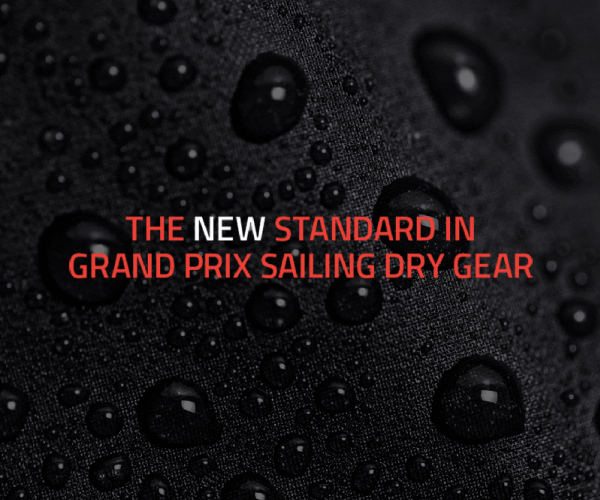




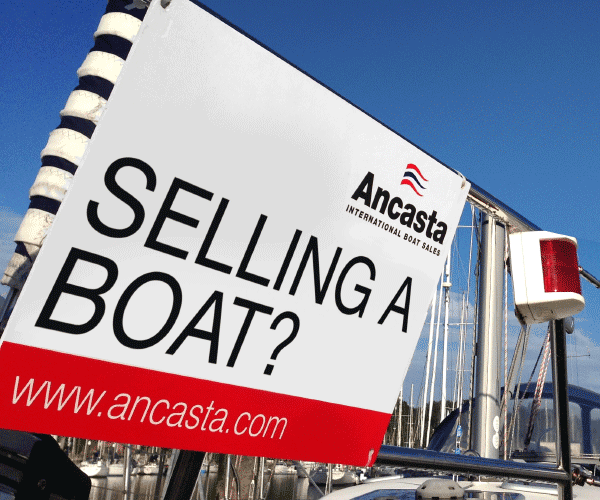

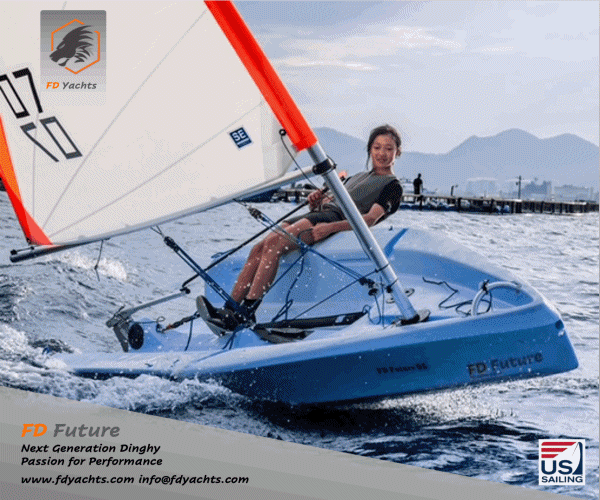
Boats for sale
| Laser 28 - Excellent example of this great design Hamble le rice |
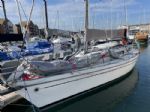 |
| Rossiter Pintail Mortagne sur Gironde, near Bordeaux |
 |
| Laser 140101 Tynemouth |
 |
List classes of boat for sale |
Lee-Bow..... Windsurfers...etc (Dons tin hat) |
Post Reply 
|
Page <1 2122232425 36> |
| Author | |||||||
Guests 
Guest Group 
|
 Post Options Post Options
 Quote Quote  Reply Reply
 Topic: Lee-Bow..... Windsurfers...etc (Dons tin hat) Topic: Lee-Bow..... Windsurfers...etc (Dons tin hat)Posted: 29 Sep 19 at 6:33pm |
||||||
|
First diagram, three boats sailing in the absence of any tide with 4 degrees leeway. The green boat makes best VMG. Red and blue are footing and pinching respectively, and VMG is slightly down.
Second diagram, the three boats are sailing in tide at the same angle to the apparent wind (but much closer to the true wind). The red boat is pointing straight into the current but due to leeway has the current on the windward bow, the green boat is leebowing (but itís path is straight into the tide) and the blue pincher is leebowing even allowing for leeway. Speed through the water for the three boats is exactly the same as the first diagram without tide (as the apparent wind is the same) but speed over the ground obviously isnít. The green boat goes literally no where to an inertial frame (land based) observer. The red footing boat slips to leeward, but VMG now matches the green boat. The blue pinching leebower slips back faster than when there was no tide! Moral of the story. The green boat sails best on a lake and best on the sea. It should not be tempted to pinch to leebow, but can foot off with no loss of speed. 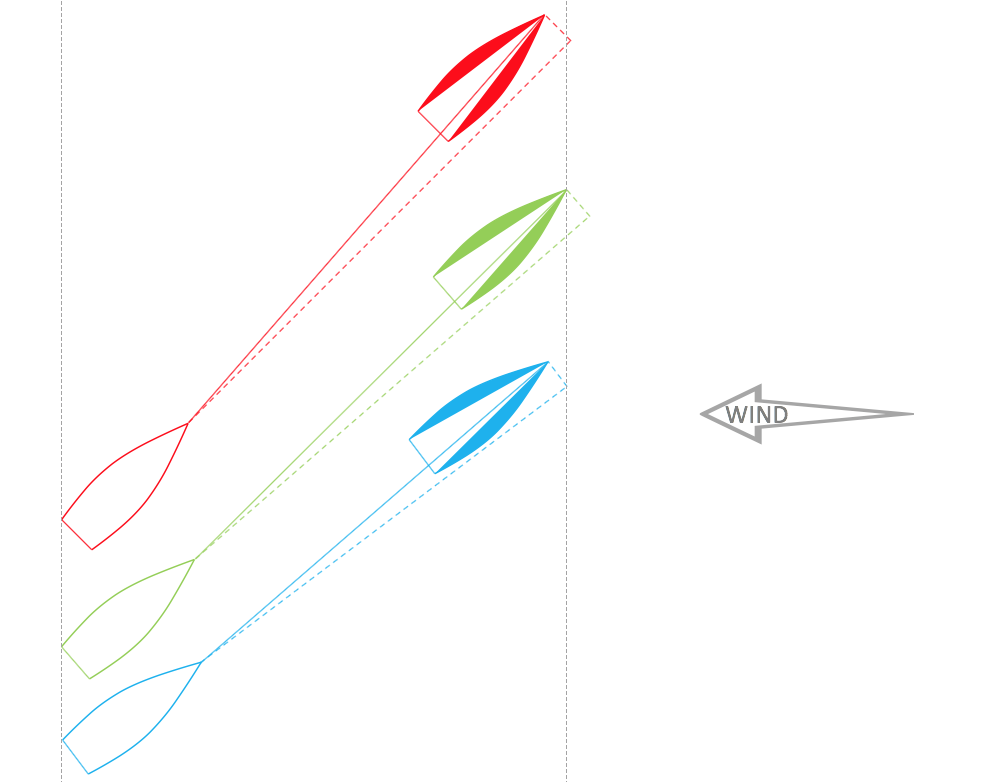
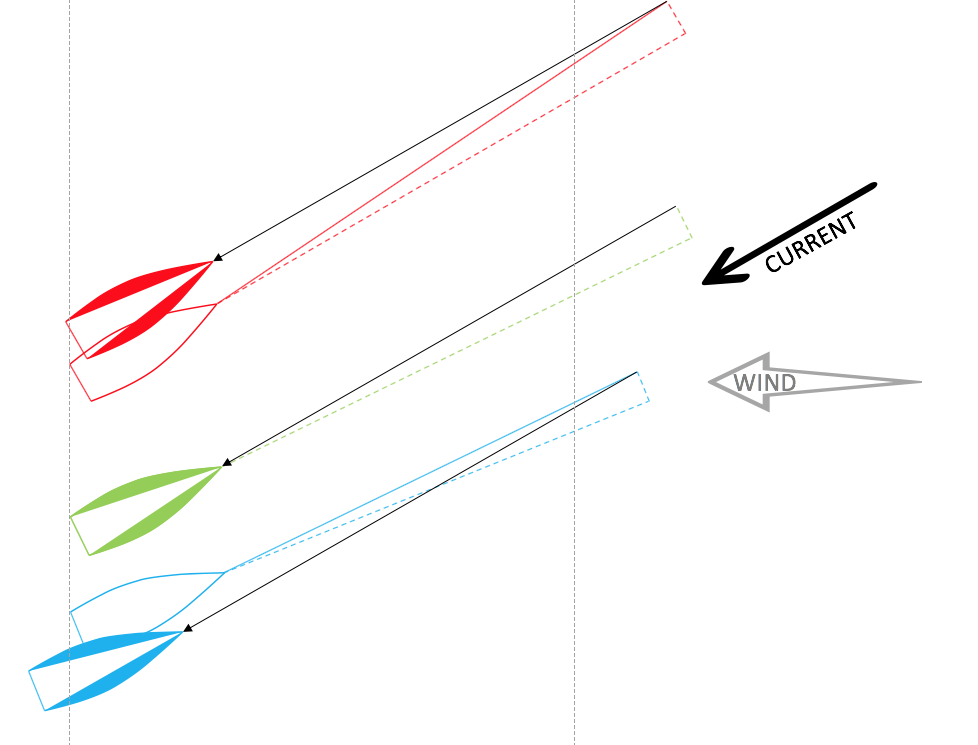
|
|||||||
 |
|||||||
Sam.Spoons 
Really should get out more 
Joined: 07 Mar 12 Location: Manchester UK Online Status: Offline Posts: 3401 |
 Post Options Post Options
 Quote Quote  Reply Reply
 Posted: 29 Sep 19 at 9:26pm Posted: 29 Sep 19 at 9:26pm |
||||||
Yes, true for 'soft' dacron sails but not for fully battened sails or to stiff laminate sails. The main advantage in the light is significant reduction in wetted area and associated drag. As soon as there is enough pressure to overcome skin friction heeling is slow in a dinghy. On a board the rounding up effect when heeled is none existent and, once there is some pressure, the extra WLL and 'grip' (when railed a Raceboard has, effectively, a long, narrow, deep hull and that is the main benefit. Also Raceboards all use fully battened/camber induced sails with hold their shape regardless so the shape thing is negated.
|
|||||||
|
Spice 346 "Flat Broke"
Blaze 671 "supersonic soap dish" |
|||||||
 |
|||||||
Guests 
Guest Group 
|
 Post Options Post Options
 Quote Quote  Reply Reply
 Posted: 30 Sep 19 at 9:19am Posted: 30 Sep 19 at 9:19am |
||||||
What number have you used for the drop in VMG? Looks like you've made up that number, which by eye doesn't look to far off. But really you'd want a speed polar if you were to be making this point on any scientific level. A footing boat will typically make less leeway and more speed for their given heading. But obviously their given heading isn't as good. A footing boat will also get a knock in apparent wind due to their additional speed. The opposite is true for a pinching boat and the best VMG is the Goldilocks somewhere in the middle. But, it's quite a complicated thing to just plug in numbers off the top of your head for and expect everyone to accept them. Also, you have a separate vector for leeway which is created from what looks like an applied angle. This produces one obvious error that can be seen by eye which is that the blue footing boat makes greater leeway in distance over time than the pinching boat because of the 4 degree standard leeway assumed for all headings. But that certainly wouldn't be the case in real life. Their leeway over time would either be similar, or possibly red pinchers would be worse (over time, and much worse as an angle away from their heading).
Blue and Red's VMG shouldn't be any different relative to the other boats in the tide than on the lake. Which tell me something has gone wrong, but with out you stating your assumption it's hard to work out what. Have you measured the vectors or is all drawn by eye? Looking at the lengths of the vectors for speed though water (without leeway) they seem different in tide versus no tide. Also, in the first diagram you compare where the aft leeward quarter is, versus bows at the end, in the second you just have a line through the starting transoms (and the gain line out right is redudant??). This artificially makes the blue pinching boat look better in the first diagram than the second, just because of how their heading orientates the boat against the VMG gain line. Again, I'm not sure just assuming a non-specified VMG difference for footing and pinching is adequate, when essentially your whole argument is about the effect that footing and inching has on your VMG (with and without tide.
The moral of this story is to include more information about the key assumptions you are making. GRFs whole premises is that when he pinches above the tide his VMG doesn't drop, because of getting 'flow' pushing the foils, or some rubbish. I think if the math had been done correctly, then the relative VMG differential between footing, pinching or the best VMG mode would be the same on a lake as it is on the sea. So, unfortunately your story is incorrect and unfortunately another good example of how with good intentions it's easy to spread bad advice. In fact, the vector lines may be correct, and it's just how you've compared bows against leeward aft quarter that is making the pincher look worse in tide versus no tide. Or some combination of the both. If you repeated this exercise but with a consistent comparison of relative positions (central axis point of the boats) and use some real life polars for angle and speed which already accounts leeway then I think you'd have something informative and useful.
Edited by mozzy - 30 Sep 19 at 9:29am |
|||||||
 |
|||||||
Old bloke 
Posting king 
Joined: 03 Nov 17 Online Status: Offline Posts: 121 |
 Post Options Post Options
 Quote Quote  Reply Reply
 Posted: 30 Sep 19 at 10:28am Posted: 30 Sep 19 at 10:28am |
||||||
|
A vast amount of time and energy being put into explaining or disproving the impossible.
The foils can only react to the speed and angle that they travel through the water. The rig can only react to the speed and angle it travels through the air. Neither care whether its the boat or the medium thats moving relative to a fixed points on the land. Grf hasnt even tried to show how his lbt transmits energy from the water or air to his boat. As Prof Brian Cox says when confronted with any kind of "woo", you can only believe in it if you don't believe in the laws of thermodynamics |
|||||||
 |
|||||||
JimC 
Really should get out more 

Joined: 17 May 04 Location: United Kingdom Online Status: Offline Posts: 6662 |
 Post Options Post Options
 Quote Quote  Reply Reply
 Posted: 30 Sep 19 at 11:16am Posted: 30 Sep 19 at 11:16am |
||||||
I think talking about leeway just confuses the issue. There isn't really any such thing. What we call leeway is the angle of attack the boat must take up to generate the amount of lift in the water required to balance the lift from the air. Hence the boat sailing faster must have less leeway, and the boat sailing slower more if the rig forces are equal (which of course they won't be). But in drawing vector diagrams leeway adds no value. What you need is the actual course made good through the water. |
|||||||
 |
|||||||
Guests 
Guest Group 
|
 Post Options Post Options
 Quote Quote  Reply Reply
 Posted: 30 Sep 19 at 11:49am Posted: 30 Sep 19 at 11:49am |
||||||
|
Yeah, fully agree.
I guess Peaky put it in, as GRF always talks about lift on the foils and the current pushing against the foil or rail to generate extra lift and peaky wanted to address that in some way. Reading between the lines peaky probably wanted to illustrate that the foils angle of attack wouldn't change because of current which is a misunderstanding the lee bow myth often wraps itself up in. However, in reality the foils angle of attack will change with speed and the footing boat should go faster. Unfortunately, the way it's added it in to vectors is counter to what happens in real life. I still think the main issues with the vectors shown are how Peaky is selecting the change in speed with heading. If those numbers are just picked out of thin air, then it really does nothing to illustrate anything than Peaky prejudice about the relative performance of pinching and footing and is likely to be skewed by his own sailing experiences. Then there is issue with measuring bows versus sterns and how the boats are rotated with heading. Then there might be issues with the actual lengths of the vectors, but we don't know that as we haven't been told speeds for the current or the boats, or their relative headings. But if you're looking for good advice, Peaky's offering of (against current) 'can foot off with no loss of speed (VMG)' is incorrect. |
|||||||
 |
|||||||
Hitcher 
Newbie 
Joined: 21 Dec 10 Online Status: Offline Posts: 38 |
 Post Options Post Options
 Quote Quote  Reply Reply
 Posted: 30 Sep 19 at 12:40pm Posted: 30 Sep 19 at 12:40pm |
||||||
|
Peaky, could you redo it, but assume it is a boat with a wide groove. VMG is equal at all three headings. (Also assume no speed loss in a tack so as not to have a difference in net VMG over a leg.)
Does the answer come out the same? |
|||||||
 |
|||||||
Guests 
Guest Group 
|
 Post Options Post Options
 Quote Quote  Reply Reply
 Posted: 30 Sep 19 at 1:04pm Posted: 30 Sep 19 at 1:04pm |
||||||
Assuming VMG is equal pinching 5 degree or footing 5 degrees then they all come out equal. Wind is 90. Green is 45 degree, Blue 40 and Red 50. All make an VMG to windward of Xm per second. 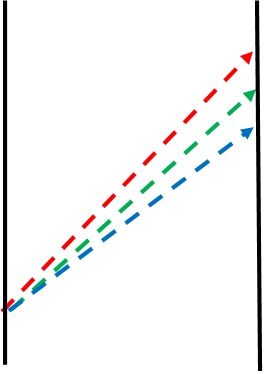 Tide is <Xms from 45 degrees. Relative VMG remains the same. They have created separation however. 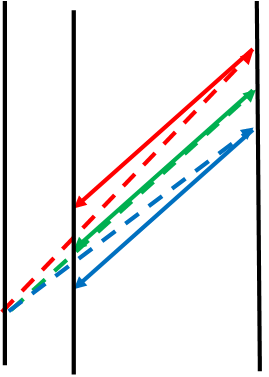 However, no boat has equal VMG across a range of heading like this. So there will always be a preferred heading which is best VMG. However, some boats will have a shallower drop off either side and so wider groove. Additionally, you'd have to be a special kind of stupid to think that is 3 boats had the same VMG and experienced the same tide, they wouldn't end up equal. So, the real question is about how VMG change with heading, which, as I don't know where Peaky got his angle v speed info from are pretty redundant. GRF would contend that he can access extra lift through change of flow over foils or 'surfaces' only in tide by doing something fanciful with body, rig, and feet and thus harness the movement of current relative to land. Which leads back to the discussion about how he can access that energy when he has no physical contact with the shore whilst sailing... and... as Old Bloke says
Edited by mozzy - 30 Sep 19 at 3:12pm |
|||||||
 |
|||||||
Guests 
Guest Group 
|
 Post Options Post Options
 Quote Quote  Reply Reply
 Posted: 30 Sep 19 at 6:14pm Posted: 30 Sep 19 at 6:14pm |
||||||
†
I don't follow Ė the blue boat is pinching not footing; the red boat is footing not pinching. At any rate, as explained above, I have assumed a constant leeway angle of 4 degrees. This assumption does not materially affect the conclusion.
So let me say first off I didn't want to get into detail on the math's, the numbers and the second order effects. I know that opens it to scrutiny but a. I'm lazy, b. I'm busy c. Most people prefer pictures to numbers d. It is unnecessary distraction. And this is the Y&Y forum, not Chesapeake Yacht Symposium or RINA Transactions. That said, I do feel the tone of your post was a little unnecessary, but maybe Iím a snowflake. Hitcher had the excellent idea of assuming a wide groove with the boats all having equal VMG in no tide. Unfortunately, Mozzyís diagram is misleading because it does not account for the large change in heading relative to the true wind that can be achieved. The diagram should look like this, which reinforces the point that footing, not pinching, is the way to go. All references to leeway removed to make it clearer. 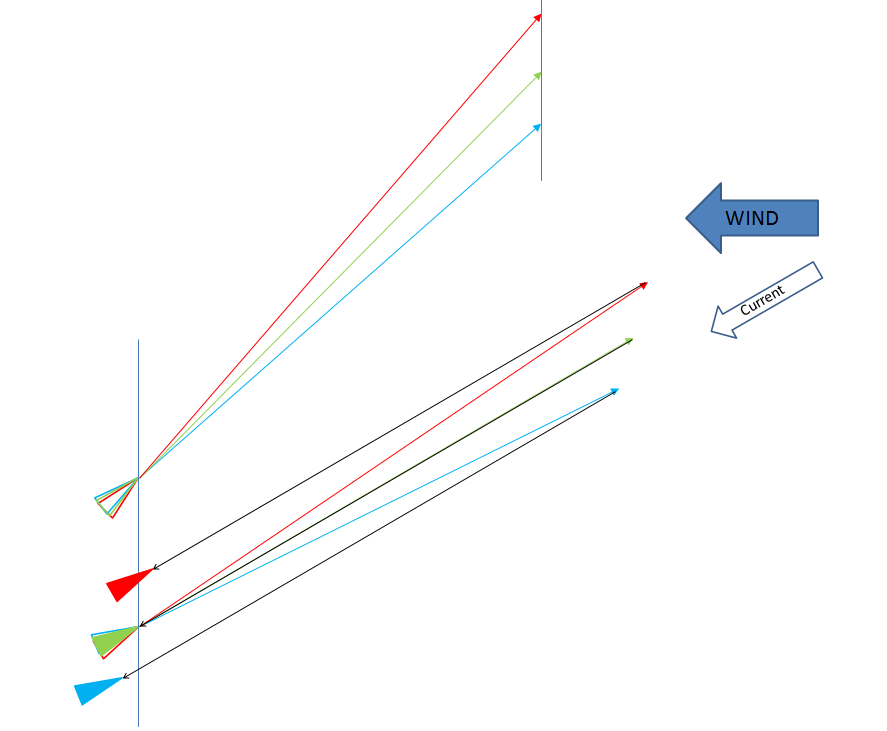 Edited by Peaky - 30 Sep 19 at 6:16pm |
|||||||
 |
|||||||
Guests 
Guest Group 
|
 Post Options Post Options
 Quote Quote  Reply Reply
 Posted: 30 Sep 19 at 7:11pm Posted: 30 Sep 19 at 7:11pm |
||||||
Generally yes, but in this case VMG, or speed for a given heading relative to wind is the crux of the discussion. So I don't think it can be ignored or generalised.
Okay, yes, if you assume the boat lifts it's board to keep leeway (AoA) the same. But again not stated and often not what happens in practice.
Okay, this I still don't get, so possibly it's my turn look stupid, and i'd like to learn. But, if their VMG is the same in no tide, if that is the premise, then how come their VMG is different before you added the tidal vector in the second diagram? Clearly the red boat has got ahead before you apply the tide. You say this is because of the wind shift, how so?
Is the wind your showing is true wind (on water) or true wind over ground? The current changes the true wind (over water) just the same for all of them. So what factor are you applying? There's obviously some additional calculation or adjustment you are making here. Can you tell me what that is? Edited by mozzy - 30 Sep 19 at 8:13pm |
|||||||
 |
|||||||
Post Reply 
|
Page <1 2122232425 36> |
| Forum Jump | Forum Permissions  You cannot post new topics in this forum You cannot reply to topics in this forum You cannot delete your posts in this forum You cannot edit your posts in this forum You cannot create polls in this forum You cannot vote in polls in this forum |
Bulletin Board Software by Web Wiz Forums® version 9.665y
Copyright ©2001-2010 Web Wiz
Change your personal settings, or read our privacy policy
Copyright ©2001-2010 Web Wiz
Change your personal settings, or read our privacy policy











 Printable Version
Printable Version Delicious
Delicious Digg
Digg Facebook
Facebook Furl
Furl Google
Google MySpace
MySpace Newsvine
Newsvine reddit
reddit StumbleUpon
StumbleUpon Twitter
Twitter Windows Live
Windows Live Yahoo Bookmarks
Yahoo Bookmarks Topic Options
Topic Options